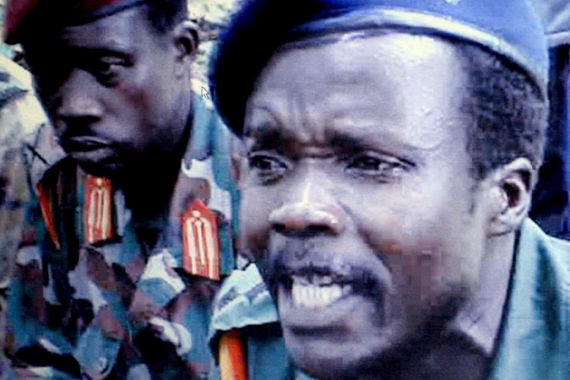Profile: The Lord’s Resistance Army
Ugandan rebel force has gained international notoriety for murdering, raping and kidnapping thousands of civilians.

 |
| An LRA rebel passes a village in 2006 on his way to a camp set up in Owinykibul in Sudan. [EPA] |
The Lord’s Resistance Army (LRA) began life in 1988 in northern Uganda.
It emerged from the remnants of the Holy Spirit Movement army founded by Alice Auma Lakwena, a priestess and distant relative of Joseph Kony, the LRA leader.
Kony, a former catechist, capitalised on a power vacuum created by the defeat of resistance movements in the north – some of which abandoned their military campaigns and made peace with the government in the 1990s – to start the LRA.
The group first operated as the United Holy Salvation Army before it was named the Uganda Christian Army/Movement and eventually the LRA. It adopted this name some time in 1992.
The LRA gained a reputation for brutality as it waged an armed rebellion seeking to remove the government of Yoweri Museveni, the Ugandan president, and rule the country on the Biblical ten commandments.
The vast majority of the LRA fighters came from the northern districts of Gulu, Kitgum and Pader.
Sustained government offensives have weakened the group’s numbers.
Forced recruitment
Most of the fighters were forcibly recruited into rebel ranks by fighters who often killed those who were reluctant to join the LRA or hacked off their ears, lips and limbs.
Although the group has been basically a ragtag army that often resorted to banditry to survive, it took the Ugandan government nearly two decades to rein them in.
After a series of defeats at the hands of the Ugandan military, the LRA sought sanctuary in the neighbouring Democratic Republic of Congo (DRC).
There, according to Human Rights Watch (HRW) senior researcher Anneke Van Woudenberg, they have become a “regional problem spread between three countries” – the DRC, Sudan and the Central African Republic (CAR).
Part of the reason the Ugandan government had difficulty defeating the LRA was because of the military support they were allegedly receiving from the Sudanese government.
Sudan says that Uganda supported the Sudanese People’s Liberation Army/Movement, which fought the Khartoum government for decades until they signed a peace deal in January 2005.
‘Protected villages’
Women and children have borne the brunt of the LRA. In 1996, the LRA raided a girl’s school and herded scores of students off into the bushes.
Some of the students died in captivity while others were later freed.
Female abductees were often forced to become wives of the rebels and some contracted Aids from their “husbands”.
The government struggled to protect villagers from the LRA, eventually setting up what it called “protected villages” to house internally displaced people.
Although the camps were within the army’s areas of operation, the LRA occasionally attacked the IDP camps and massacred civilians.
In 2005, the International Criminal Court (ICC) in The Hague indicted Kony – along with several of his senior commanders – for war crimes and crimes against humanity.
The indictment was a sticking a point in negotiations – which began in 2006 – brokered by the southern Sudan government between the LRA and the Ugandan government to try to end the conflict peacefully.
Irrevocable warrant
The LRA wanted their leaders to be tried by Ugandan courts, but the ICC has maintained that once the arrest warrants are issued, they cannot be taken back.
The court also doubted the independence of Ugandan courts and their ability to deliver justice of the kind that meets international standards.
Kony never turned up for the talks, often sending representatives to the talks.
The talks collapsed in 2008 after the LRA and the government accused each other of violating the terms of the ceasefire agreement.
By this time the LRA did not have any more bases in Uganda and the rebels were holed up in the jungles of the DRC.
In December 2008, a major offensive was launched against Kony by a joint force of Ugandan, Rwandan and Congolese troops, but he escaped and remains at large.
Since 2008, the LRA has killed more than 2,400 people and abducted more than 3,400, according to the US State Department.
The UN estimates that over 380,000 people are displaced across CAR, the DRC and South Sudan as a result of LRA activity.
In 2009, US President Barack Obama signed into law the Lord’s Resistance Army Disarmament and Northern Uganda Recovery Act, legislation aimed at stopping Joseph Kony and the LRA.
A year later in November, Obama delivered the strategy to disarm Kony and the LRA.
On October 2011, the US president announced that he would deploy 100 combat-equipped advisors to Uganda to help efforts against the LRA.
The US also offered bounties of up to $5m each for Kony and some of his top LRA aides in April 2013.
Uganda troops captured 19 LRA rebels in CAR in December 2013, which was considered to be a sizeable victory in the hunt for members of the notorious group.
And the Pentagon announced in March that it would send four aircraft, and the 150 troops needed to maintain them, to hunt for Kony in South Sudan, CAR, Uganda and the DRC.